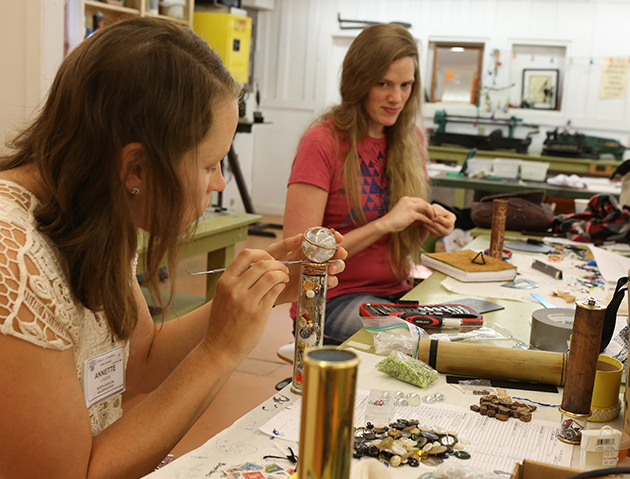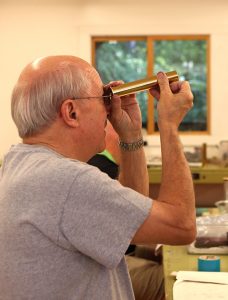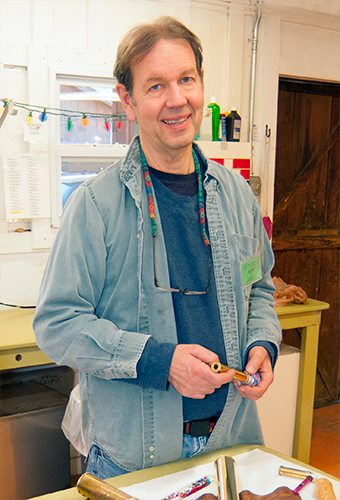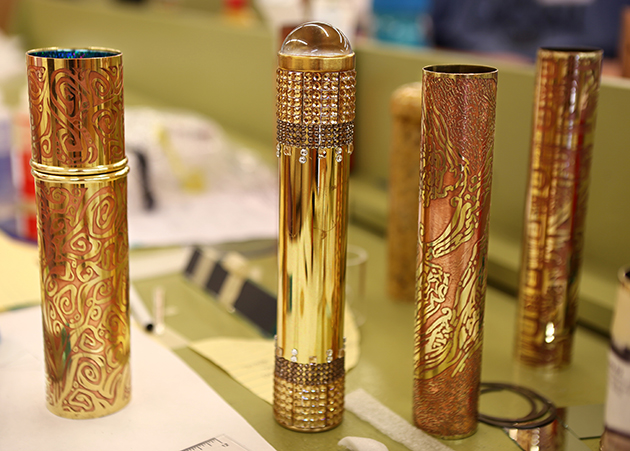
18 Aug Adventures in Kaleidoscope Land
Earlier this month, I had the chance to take a class on kaleidoscopes with longtime Folk School instructor Scott Cole. I’ve taken many classes at the Folk School, but I’ll admit I was a little daunted to work with glass and metal, both materials I’ve had little experience with.
The first night, we set up our studio as a group, looked at examples of the many styles of kaleidoscopes, and had our first small challenge: taping a set of three long mirrors together to create the reflective pattern found in many kaleidoscopes. Our first night’s homework was deceptively simple: take home your mirrors and master their assembly.
The next day, Scott walked us through the process for making a basic brass kaleidoscope. We learned to cut glass, cut our mirrors, glue with epoxy (occasionally a sticky mess for some of us), and how to shape small pieces of glass for our kaleidoscopes’ object cell. While our first kaleidoscopes had matching exteriors and mirror systems, we each found ways to personalize our scopes in ways that matched our individual sense of color, movement, and texture.
 As the week progressed, each of us students had different techniques we wanted to try, and new materials we wanted to use for the body of our scopes. Scott was attentive to each of our needs, goals, and ideas, and tailored class demos to what we wanted to work on. Tuesday was full of experimenting on my own with different materials and techniques. As with any Folk School class, I felt some frustration and uncertainty as I fumbled with new tools and techniques. The day was also full of small delights and successes: creating little glass jewels and shapes with the propane torch (an experience similar to pulling taffy), or learning to etch designs into metal, allowing us to beautifully decorate the outer body of our kaleidoscopes. The bubbling iron sulfate bath used to etch our kaleidoscope tubes was reminiscent of a mad scientist’s experiment and the results were striking.
As the week progressed, each of us students had different techniques we wanted to try, and new materials we wanted to use for the body of our scopes. Scott was attentive to each of our needs, goals, and ideas, and tailored class demos to what we wanted to work on. Tuesday was full of experimenting on my own with different materials and techniques. As with any Folk School class, I felt some frustration and uncertainty as I fumbled with new tools and techniques. The day was also full of small delights and successes: creating little glass jewels and shapes with the propane torch (an experience similar to pulling taffy), or learning to etch designs into metal, allowing us to beautifully decorate the outer body of our kaleidoscopes. The bubbling iron sulfate bath used to etch our kaleidoscope tubes was reminiscent of a mad scientist’s experiment and the results were striking.
Each student brought their own creative touch to their kaleidoscopes during the week. My neighbor in class, work-study Annette Lowder, had brought an array of tiny knick-knacks from home and incorporated them into her work. Miniature figurine gas pumps, pitchforks, and people can be seen tumbling in her scopes. She also repurposed everyday objects in her work: an ordinary sewing bobbin became an interesting  eyepiece on one kaleidoscope. My other neighbor, Buzz Ahrold of Iowa, revisited his basic brass kaleidoscope from Day 1, adding hand-braided rope and metal extensions until the exterior looked like an old nautical spyscope. Others worked on making kaleidoscopes from materials like bamboo, or focused on specialized techniques like creating an oil cell for the bits of kaleidoscope “magic” to float in.
eyepiece on one kaleidoscope. My other neighbor, Buzz Ahrold of Iowa, revisited his basic brass kaleidoscope from Day 1, adding hand-braided rope and metal extensions until the exterior looked like an old nautical spyscope. Others worked on making kaleidoscopes from materials like bamboo, or focused on specialized techniques like creating an oil cell for the bits of kaleidoscope “magic” to float in.
By the end of the week, I had made four kaleidoscopes, each with its own personality, flaws, and unique capacity to delight and surprise. In fact, the element of surprise was one of the greatest treats of this class. No matter how the exterior may be decorated, how carefully the internal mirror system might be arranged, or how deliberately the contents of the kaleidoscope cell might be planned, the fun moment of truth is always when you put your kaleidoscope-in-progress up to your eye, and see for the first time what patterns of color, line, and shape evolve and disappear as you rotate the scope. The idea that something I’ve made could continually surprise me, long after finishing the project, is such a delight, and not something I’ve encountered with other forms of art and craft.
Overall, this class was a joy. Scott’s instruction was clear and straightforward, but with a solid dose of encouragement to experiment and explore. I also found myself in a supportive group of students, and as the Folk School blessing says, I even made some new friends.





No Comments